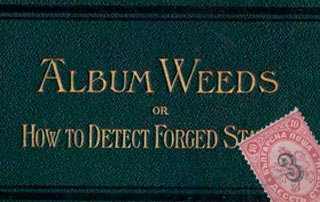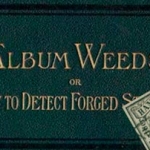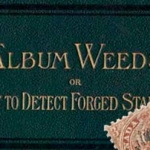Album Weeds – Bulgaria
Provisional Stamps
 1884-1885. 3, surcharged, in black, on the 10 Stotinki, rose.
1884-1885. 3, surcharged, in black, on the 10 Stotinki, rose.
Genuine
All the outlines of the 3, except where they are thickened, as shading, are extremely thin. In the hollow of the upper half there is a small projection,—a sort of upright oblong,—and this projection is only outlined; i.e., not solid black. To the right of the shadow, inside the lower limb, there is also an outlined space. The thick, shaded part of the front of the upper limb does not touch the outline of the central projection. Where the shading from the back comes into this central projection or tongue, it does so almost horizontally, so that, if prolonged to the left, it would pass out, almost at the very center of the tongue.
Forged
It will be understood, of course, that, in the forgeries here described, the stamps are genuine, but the surcharges are counterfeited. All the outlines of the 3 are a good deal too thick; the very thinnest parts being quite 1/4 mm. thick; while the genuine surcharge is very much thinner. The little projection inside the hollow of the top half of the numeral is solid black. The inside shading to the lower limb (which is, in the genuine, composed of two similar pieces, the left-hand one solid and the right-hand one outlined) is so coarsely done that it appears almost all solid. The thick, shaded part of the front of the upper limb touches the top, left corner of the central tongue. The shading from the back, where it comes into this central tongue, slopes down to the left; so that, if prolonged to the left, it would pass out, almost at the bottom corner of the tongue. The extra outline, to right of the lower limb, is blotched and ragged, just at the center of the back of the said lower limb. This is not the case with the genuine.
 1884-1885, 5 surcharged, in black or red, on the 30 Stotinki, blue and brown.
1884-1885, 5 surcharged, in black or red, on the 30 Stotinki, blue and brown.
Genuine
In the hollow inside of the body of the 5, the thickened part of the shading of the inside of the tail just touches the similar, thickened shading of the bottom of the neck, so that the central oval is really closed, although the front part of the division between the neck and the tail is open. There is an outline (inside the oval) to the thickened part of the shading of the upper part of the oval. The width of the neck of the 5, measured inside the colored lines, is 3/4 mm. The tail of the 5 does not project to the left of the outline of the front of the neck: that is to say, the front outline of the neck, if prolonged downwards, would coincide with the outline of the tail.
First Forgery
I have only seen this in black, but it may possibly exist in red also. No part of the tail of the numeral touches the shading below the neck, so that the oval inside the body is open. There is an outline, not filled up with colour, to the bottom of the tail, inside the oval. In the genuine, this outline is filled up with colour, and makes what I have called the “thickened shading” of the inside of the tail. If I have made myself understood, this should be an easy test. The width of the neck of the 5, measured inside the outlines, is 3/4 mm., like the genuine. The tail of the 5 does not point directly upwards, but rather obliquely upwards, towards the left; thus a line drawn down along the front of the neck would cut deeply into the end of the tail. This is another easy test.
Second Forgery
I have only seen this in black. In the genuine stamp, the thickened shading, inside the upper part of the oval, has an outline, following the curve of the shading, and about 1/2 mm. distant from it. In this forgery, the space between the shading and this outline is filled up with solid color, thus making that part of the shading twice as thick as it ought to be. My specimen is heavily postmarked, but as far as I can see, the oval is perfectly open, as no part of the tail touches the neck. The numeral is too narrow; the width across the neck, between the outlines, being less than 1/2 mm., instead of 3/4 mm. The curved head is also far too narrow; it measures about 1/4 mm. across, between the outlines, instead of about 3/4 mm.
Postmarks
Forged.—All my forgeries are cancelled with part of a large circle, containing an outlined star.
 1884-1885. 15, surcharged, in red, on the 25 Stotinki., blue and pale blue.
1884-1885. 15, surcharged, in red, on the 25 Stotinki., blue and pale blue.
Genuine
The serif to the head of the 1 is the same width all the way, from where it leaves the body of the numeral to its end; i.e., nearly 3/4 mm. wide. The head of the 5 is slightly concave, but it slopes down decidedly to the right, so that the right-hand end is considerably lower than where it leaves the upright stroke. The vertical outline of the front of the neck, to the top of the numeral, measures 7 mm.
Forged
The serif to the head of the 1 decreases gradually in thickness towards its point, so that, at the said point, it is almost a hair-line. The projecting head of the 5 is very concave, and it rises, instead of sloping downwards to the right, so that the right-hand end is considerably higher, instead of lower, than where it leaves the upright part. This is a very easy test. The vertical outline of the front of the neck, to the top of the numeral, measures less than 6b mm. The oval body of the 5 is decidedly smaller than in the genuine, but I cannot give the measurements, oh account of the difficulty of fixing the points from which to measure. However, I fancy the other tests will be found sufficient.
Bogus Provisional
10, in blue, on 15 Stotinki., lilac-mauve.
There never was, of course, a genuine stamp like this. My specimen has the bogus surcharge printed in ordinary (i.e., not fancy) numerals, 5 1/2 mm. high, in pale blue.
From: ‘Album Weeds’, 3rd edition by R. B. Eareé. 1906




Leave a Reply
Want to join the discussion?Feel free to contribute!